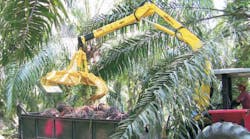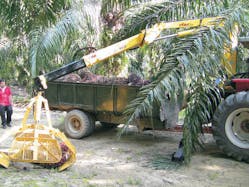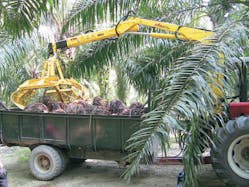Palm nuts are still widely harvested manually. Palm nut bunches are cut from trees with a saw mounted at the end of a long pole. The fallen bunches are manually collected into piles, and a crane mounted to a tractor loads them into a trailer. The full trailer then goes to a mill, where the nuts are pressed to squeeze out the oil.
This is a typical scenario in Malaysia, where plantation owners are always looking for affordable equipment that is reliable and easy to operate. Hyva Malaysia, a division of Hyva Group, BV, Netherlands, has been advising and supplying plantation owners and managers for more than ten years with equipment such as Hyvalift hook loaders and cranes.
Following discussions with customers, the need became clear from oil palm growers for a new generation of crane to assist in the harvesting of the fruit bunches from oil palm trees. The crane would have to be stronger, more compact, lighter, and less costly to maintain than the cranes in use at that time.
Hyva Malaysia worked in conjunction with Hyva’s Crane Division to develop the HB50FFB crane, a specially designed agricultural crane tailored to the day-to-day operating demands of large-scale, commercial oil palm harvesting. It has a lifting capacity of 4.8 tonnes and a reach of 4.98 m.
The HB50FFB has its main cylinder mounted inside the crane’s telescopic boom. This protects the piston rod and seals from external damage and sand, dirt, water, and other contaminants while also keeping the crane easy to disassemble.
Designers also provided a pair of hydraulic cylinders for the swing function. This provides greater torque tan a single cylinder for pivoting the boom and also provides load balancing by applying torque to opposite sides of the swing drive’s rack-and-pinion assembly.
Two pairs of quick-acting hydraulic couplings are provided for supplying auxiliary hydraulic functions.
The crane is normally mounted to a truck or trailer bed and left unfolded. To keep erratic movements of the vehicle in transit from damaging the crane, the over-center valves for the crane’s swing and main boom can be bypassed. This allows the crane to follow the vehicle’s movements.
For more information, email [email protected] or visit www.hyvacrane.com.





